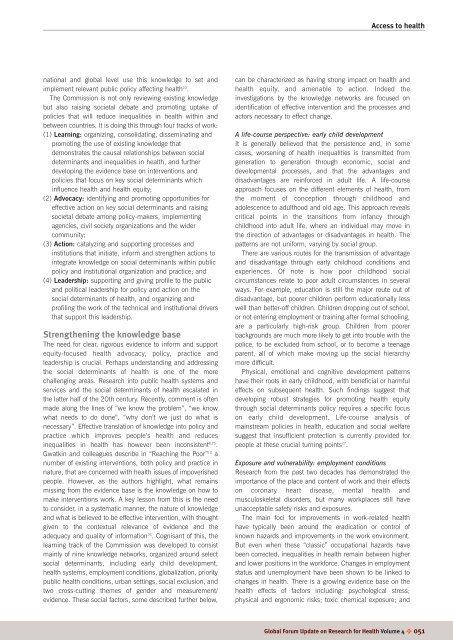Combining health and social protection measures to reach the ultra ...
Combining health and social protection measures to reach the ultra ...
Combining health and social protection measures to reach the ultra ...
- No tags were found...
Create successful ePaper yourself
Turn your PDF publications into a flip-book with our unique Google optimized e-Paper software.
Access <strong>to</strong> <strong>health</strong>national <strong>and</strong> global level use this knowledge <strong>to</strong> set <strong>and</strong>implement relevant public policy affecting <strong>health</strong> 23 .The Commission is not only reviewing existing knowledgebut also raising societal debate <strong>and</strong> promoting uptake ofpolicies that will reduce inequalities in <strong>health</strong> within <strong>and</strong>between countries. It is doing this through four tracks of work:(1) Learning: organizing, consolidating, disseminating <strong>and</strong>promoting <strong>the</strong> use of existing knowledge thatdemonstrates <strong>the</strong> causal relationships between <strong>social</strong>determinants <strong>and</strong> inequalities in <strong>health</strong>, <strong>and</strong> fur<strong>the</strong>rdeveloping <strong>the</strong> evidence base on interventions <strong>and</strong>policies that focus on key <strong>social</strong> determinants whichinfluence <strong>health</strong> <strong>and</strong> <strong>health</strong> equity;(2) Advocacy: identifying <strong>and</strong> promoting opportunities foreffective action on key <strong>social</strong> determinants <strong>and</strong> raisingsocietal debate among policy-makers, implementingagencies, civil society organizations <strong>and</strong> <strong>the</strong> widercommunity;(3) Action: catalyzing <strong>and</strong> supporting processes <strong>and</strong>institutions that initiate, inform <strong>and</strong> streng<strong>the</strong>n actions <strong>to</strong>integrate knowledge on <strong>social</strong> determinants within publicpolicy <strong>and</strong> institutional organization <strong>and</strong> practice; <strong>and</strong>(4) Leadership: supporting <strong>and</strong> giving profile <strong>to</strong> <strong>the</strong> public<strong>and</strong> political leadership for policy <strong>and</strong> action on <strong>the</strong><strong>social</strong> determinants of <strong>health</strong>, <strong>and</strong> organizing <strong>and</strong>profiling <strong>the</strong> work of <strong>the</strong> technical <strong>and</strong> institutional driversthat support this leadership.Streng<strong>the</strong>ning <strong>the</strong> knowledge baseThe need for clear, rigorous evidence <strong>to</strong> inform <strong>and</strong> supportequity-focused <strong>health</strong> advocacy, policy, practice <strong>and</strong>leadership is crucial. Perhaps underst<strong>and</strong>ing <strong>and</strong> addressing<strong>the</strong> <strong>social</strong> determinants of <strong>health</strong> is one of <strong>the</strong> morechallenging areas. Research in<strong>to</strong> public <strong>health</strong> systems <strong>and</strong>services <strong>and</strong> <strong>the</strong> <strong>social</strong> determinants of <strong>health</strong> escalated in<strong>the</strong> latter half of <strong>the</strong> 20th century. Recently, comment is oftenmade along <strong>the</strong> lines of “we know <strong>the</strong> problem”, “we knowwhat needs <strong>to</strong> do done”, “why don’t we just do what isnecessary”. Effective translation of knowledge in<strong>to</strong> policy <strong>and</strong>practice which improves people’s <strong>health</strong> <strong>and</strong> reducesinequalities in <strong>health</strong> has however been inconsistent 8,25 .Gwatkin <strong>and</strong> colleagues describe in “Reaching <strong>the</strong> Poor” 10 anumber of existing interventions, both policy <strong>and</strong> practice innature, that are concerned with <strong>health</strong> issues of impoverishedpeople. However, as <strong>the</strong> authors highlight, what remainsmissing from <strong>the</strong> evidence base is <strong>the</strong> knowledge on how <strong>to</strong>make interventions work. A key lesson from this is <strong>the</strong> need<strong>to</strong> consider, in a systematic manner, <strong>the</strong> nature of knowledge<strong>and</strong> what is believed <strong>to</strong> be effective intervention, with thoughtgiven <strong>to</strong> <strong>the</strong> contextual relevance of evidence <strong>and</strong> <strong>the</strong>adequacy <strong>and</strong> quality of information 26 . Cognisant of this, <strong>the</strong>learning track of <strong>the</strong> Commission was developed <strong>to</strong> consistmainly of nine knowledge networks, organized around select<strong>social</strong> determinants, including early child development,<strong>health</strong> systems, employment conditions, globalization, prioritypublic <strong>health</strong> conditions, urban settings, <strong>social</strong> exclusion, <strong>and</strong>two cross-cutting <strong>the</strong>mes of gender <strong>and</strong> measurement/evidence. These <strong>social</strong> fac<strong>to</strong>rs, some described fur<strong>the</strong>r below,can be characterized as having strong impact on <strong>health</strong> <strong>and</strong><strong>health</strong> equity, <strong>and</strong> amenable <strong>to</strong> action. Indeed <strong>the</strong>investigations by <strong>the</strong> knowledge networks are focused onidentification of effective intervention <strong>and</strong> <strong>the</strong> processes <strong>and</strong>ac<strong>to</strong>rs necessary <strong>to</strong> effect change.A life-course perspective: early child developmentIt is generally believed that <strong>the</strong> persistence <strong>and</strong>, in somecases, worsening of <strong>health</strong> inequalities is transmitted fromgeneration <strong>to</strong> generation through economic, <strong>social</strong> <strong>and</strong>developmental processes, <strong>and</strong> that <strong>the</strong> advantages <strong>and</strong>disadvantages are reinforced in adult life. A life-courseapproach focuses on <strong>the</strong> different elements of <strong>health</strong>, from<strong>the</strong> moment of conception through childhood <strong>and</strong>adolescence <strong>to</strong> adulthood <strong>and</strong> old age. This approach revealscritical points in <strong>the</strong> transitions from infancy throughchildhood in<strong>to</strong> adult life, where an individual may move in<strong>the</strong> direction of advantages or disadvantages in <strong>health</strong>. Thepatterns are not uniform, varying by <strong>social</strong> group.There are various routes for <strong>the</strong> transmission of advantage<strong>and</strong> disadvantage through early childhood conditions <strong>and</strong>experiences. Of note is how poor childhood <strong>social</strong>circumstances relate <strong>to</strong> poor adult circumstances in severalways. For example, education is still <strong>the</strong> major route out ofdisadvantage, but poorer children perform educationally lesswell than better-off children. Children dropping out of school,or not entering employment or training after formal schooling,are a particularly high-risk group. Children from poorerbackgrounds are much more likely <strong>to</strong> get in<strong>to</strong> trouble with <strong>the</strong>police, <strong>to</strong> be excluded from school, or <strong>to</strong> become a teenageparent, all of which make moving up <strong>the</strong> <strong>social</strong> hierarchymore difficult.Physical, emotional <strong>and</strong> cognitive development patternshave <strong>the</strong>ir roots in early childhood, with beneficial or harmfuleffects on subsequent <strong>health</strong>. Such findings suggest thatdeveloping robust strategies for promoting <strong>health</strong> equitythrough <strong>social</strong> determinants policy requires a specific focuson early child development. Life-course analysis ofmainstream policies in <strong>health</strong>, education <strong>and</strong> <strong>social</strong> welfaresuggest that insufficient <strong>protection</strong> is currently provided forpeople at <strong>the</strong>se crucial turning points 27 .Exposure <strong>and</strong> vulnerability: employment conditionsResearch from <strong>the</strong> past two decades has demonstrated <strong>the</strong>importance of <strong>the</strong> place <strong>and</strong> content of work <strong>and</strong> <strong>the</strong>ir effectson coronary heart disease, mental <strong>health</strong> <strong>and</strong>musculoskeletal disorders, but many workplaces still haveunacceptable safety risks <strong>and</strong> exposures.The main foci for improvements in work-related <strong>health</strong>have typically been around <strong>the</strong> eradication or control ofknown hazards <strong>and</strong> improvements in <strong>the</strong> work environment.But even when <strong>the</strong>se “classic” occupational hazards havebeen corrected, inequalities in <strong>health</strong> remain between higher<strong>and</strong> lower positions in <strong>the</strong> workforce. Changes in employmentstatus <strong>and</strong> unemployment have been shown <strong>to</strong> be linked <strong>to</strong>changes in <strong>health</strong>. There is a growing evidence base on <strong>the</strong><strong>health</strong> effects of fac<strong>to</strong>rs including: psychological stress;physical <strong>and</strong> ergonomic risks; <strong>to</strong>xic chemical exposure; <strong>and</strong>Global Forum Update on Research for Health Volume 4 ✜ 051















![[re-tender] RFQ for supply of Diesel Generator - Brac](https://img.yumpu.com/44421374/1/186x260/re-tender-rfq-for-supply-of-diesel-generator-brac.jpg?quality=85)
